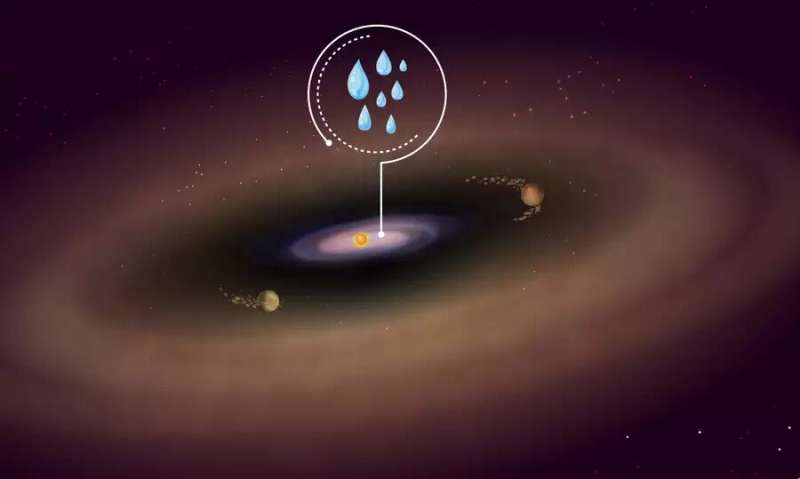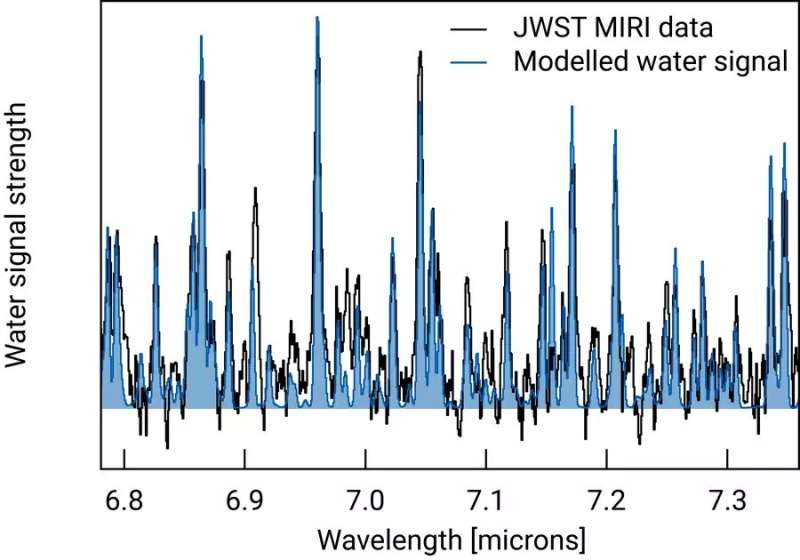This article has been reviewed according to Science X's editorial process and policies. Editors have highlighted the following attributes while ensuring the content's credibility:
fact-checked
peer-reviewed publication
trusted source
proofread
JWST observations find water for the first time in the inner disk around a young star with giant planets

Using the James Webb Space Telescope, the MPIA-led MINDS research collaboration discovered water in the inner region of a disk of gas and dust around the young star PDS 70. Astronomers expect terrestrial planets to be forming in that zone. This is the first detection of that kind in a disk that hosts at least two planets. Any rocky planets produced in the inner disk would benefit from a substantial local water reservoir, improving the chances of habitability later on.
This finding offers evidence of a mechanism to supply water to potentially habitable planets already during their formation, in addition to later impacts of water-bearing asteroids.
Water is essential for life on Earth. However, scientists debate how it reached the Earth and whether that process also could make rocky exoplanets around other stars habitable.
The preferred mechanism is a supply by water-bearing asteroids bombarding a young planet's surface. "We now may have found evidence water could also serve as one of the initial ingredients of rocky planets and be available at birth," says Giulia Perotti, an astronomer at the Max Planck Institute for Astronomy (MPIA) in Heidelberg, Germany. She is the main author of a research article to appear in the journal Nature that reports on the detection of water in the planet-forming disk of the young star PDS 70, about 370 light-years away.
Water in the inner disk of PDS 70
Observations with MIRI (Mid-InfraRed Instrument) on board the James Webb Space Telescope (JWST) discovered water near the disk center, close to the host star PDS 70. In the solar system, this is the region where rocky planets orbit the sun. According to the analysis, the water is in the form of hot vapor, blazing at a temperature of around 330° Celsius (600° Kelvin).
"This discovery is extremely exciting, as it probes the region where rocky planets similar to Earth typically form," MPIA Director Thomas Henning points out. He is a co-author of the underlying article, Co-PI (principal investigator) of MIRI, and the PI of the MINDS (MIRI Mid-Infrared Disk Survey) program. MINDS is a JWST guaranteed-time program involving research institutes from 11 European countries. This survey aims to identify the properties of disks made of gas and dust around young stars, which can teach us about the conditions that determine the composition of planets potentially forming there.
PDS 70 is the first relatively old disk—approximately 5.4 million years old—where astronomers found water. Over time, the gas and dust content of planet-forming disks declines. Either the central star's radiation or wind remove material like dust and gas, or the dust grows into larger objects that eventually form planets. As previous studies failed to detect water in the central regions of similarly evolved disks, astronomers suspected it might not survive the harsh stellar radiation, leading to dry rocky planet-forming environments.

Observing PDS 70 with MIRI on board the JWST was the key to challenging that hypothesis. As a result, the inner perimeters of evolved and dust-depleted disks may not be so dry after all. If so, many terrestrial planets forming in those zones might be born with a key ingredient to sustain life.
The water supply of terrestrial planets—nature versus nurture
However, scientists have not yet found any planets near the PDS 70 disk center so far. Instead, astronomers detected two gas-giant planets farther out, PDS 70 b and c. They accumulated surrounding dust and gas while orbiting their host star during their growth, creating a wide annular gap almost void of any detectable material.
Still, any rocky planets forming in a water-rich environment closer to the star would benefit from a water supply at the beginning of their life cycles. Therefore, in addition to water carried to initially dry rocky planets via a lengthy process involving asteroids as a somewhat random cosmic transport system, this new result opens the door for a potentially sustainable mechanism that provides water to planets already at birth.
It is not difficult to imagine that such a scenario could improve the chances of finding habitable rocky planets with plenty of water to support life. The progress of the MINDS program will eventually show whether water is common in the terrestrial planet-forming zones of evolved disks around young stars or whether PDS 70 is merely an exception.
What is the water's origin?
Since the presence of water was somewhat unexpected, the MINDS team is investigating several scenarios to explain their find.
One possibility entails water being a remnant from an initially water-rich nebula preceding the disk stage. Water is fairly common, specifically in its frozen state, covering tiny dust particles. When subjected to heat near a forming star, the water evaporates and mixes with the other gases. Unfortunately, water molecules are quite fragile and break into smaller constituents such as hydrogen and oxygen when hit by the damaging UV radiation from the nearby star. However, surrounding material such as dust and the water molecules themselves serve as a protective shield. As a result, at least some of the water detected near PDS 70 could have survived destruction.
Another source might be gas entering from the outer rims of the PDS 70 disk. Under certain circumstances, oxygen and hydrogen gas may combine and form water vapor. In addition, the drag of the moving gas may pull along water-rich dust particles migrating in from the prominent outer dust ring. The central star is so faint that it cannot evaporate the water ice at the distance of that ring. Only when the dust grains enter the inner disk close to the star, the ice turns into a gas.
"The truth probably lies in a combination of all those options," says Perotti. "Still, it is likely that one mechanism plays a decisive role in sustaining the water reservoir of the PDS 70 disk. The future task will be to find out which one it is."
Toward completing the picture
JWST and MIRI are powerful tools. Nevertheless, they only provide some aspects of the whole picture. Like a painting that needs many different colors to convey its message, astronomers apply different kinds of observations and cover a wide range of wavelengths to obtain information and complete their understanding.
In this case, the team used MIRI's spectrograph to decompose the infrared radiation received from PDS 70 into signatures of small wavelength ranges—similar to distinguishing a single color into many different shades. This way, the team isolated a wealth of individual water signatures they used to calculate temperatures and densities.
The astronomers have already obtained additional observations with ground-based telescopes to complete the picture. In addition, they are eagerly awaiting another set of JWST observations that would deliver detailed images of the inner PDS 70 disk. And perhaps, its structure will reveal hints of additional terrestrial planets or the somewhat larger sub-Neptunes forming inside the water reservoir.
More information: Giulia Perotti, Water in the terrestrial planet-forming zone of the PDS 70 disk, Nature (2023). DOI: 10.1038/s41586-023-06317-9. www.nature.com/articles/s41586-023-06317-9
Journal information: Nature
Provided by Max Planck Society





















